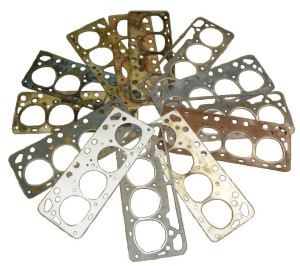Because an engine may be borderline in regards to the compression ratio when it comes to ignition timing or fuel octane requirements, it’s important that all values used in the compression ratio calculation be as accurate as possible. This includes the head gasket volume which many times isn’t stated on the package or in any reference material. For a conventional or mainstream engine where the fire ring in the head gasket is perfectly round, the hole size in the gasket can be measured and the volume calculated appropriately. But the Ford Y-Block has an irregular shape to the fire ring seal which throws special nuances into the measuring of this volume. But there’s no need for guess work when it comes to obtaining this volume value as it can be derived by doing some simple measurements on an existing head gasket and then performing a little bit of math.
Having a compressed head gasket similar to the one that’s actually going to used for the engine in question will be a starting point as head gaskets from the different manufacturers will vary. Using a micrometer or dial caliper, measure the gasket thickness of a used and already compressed head gasket. You’ll end up with a value that reads in thousandts of an inch. The next measurement needed is the inside distance around the head gaskets’ combustion chamber sealing ring and this measurement also needs to be in inches. This could be done a variety of ways but I’ll outline a couple that are inexpensive and effective. The first is to simply take a piece of string or wire, wrap it around the inside edge of the sealing ring, and cut the ends so they butt up against each other. What you have now is a length of material that is the same length of the perimeter of the head gaskets combustion chamber sealing ring and can be measured for overall length once it has being straightened out. Another method is to simply trace the head gaskets combustion chamber shape on a piece of paper or cardboard and then use a ‘map route distance reader’ to measure the distance around the head gasket sealing shape with the end value being in inches.
Once you have a known length around the head gaskets’ sealing ring and the compressed gasket thickness, there is now enough information to do the actual calculation for the head gasket volume.
Here’s the basic formula:
((sealing ring distance in inches / 3.1416) squared) X (compressed gasket thickness in thousandts of inches) X (12.87) = head gasket volume cc’s.
Here’s an example where a particular head gasket measured out at 13.0” for the combustion chamber seal and was 0.041” thick.
(13” / 3.1416)² X (0.041”) X (12.87) = 9.04cc
Here are some known head gasket values for the Ford Y-Block engine.
Best Gasket for regular bores 12.91” X 0.046” = 10.00cc
Best Gasket #582G (3.937” bore) 12.99” X 0.046” = 10.12cc
Best Gasket (4.030” bore) 13.35” X 0.046” = 10.69cc
Fel Pro #7999PT (Permatorq Blue) 12.95” X 0.044” = 9.62cc
Fel Pro Multi-Layer (old design) 12.60” X 0.039” = 8.07cc
Fitz 3 layer (metal,comp,metal) 12.80” X 0.048” = 10.25cc
Fitz 2 layer (metal,composition) 12.80” X 0.050” = 10.67cc
Fitzgerald #0645 (metal/metal) 12.76” X 0.031” = 6.58cc (40+ yrs old)
Flatout #FOG9123.5 (3.830” bore) 12.64” X 0.040” = 8.33cc (copper)
Ford steel shim C1AE-6051-B 12.68” X 0.025” = 5.24cc
Ford steel shim C3TE-6051-E 12.68” X 0.026” = 5.45cc
McCord p/n Mc6392M 12.79” X 0.048” = 10.24cc
ROL Gaskets #HG32120 12.79” X 0.045” = 9.61cc
SCE copper 12.99” X 0.042” = 9.24cc
Victor #1176TC composition 12.95” X 0.043” = 9.40cc
Victor #1176BS steel shim 12.68” X 0.025” = 5.24cc
This information is just one more tool in guaranteeing the accuracy of the static compression ratio check on a given engine. Special thanks goes to Michael Henaults for providing some of the head gaskets for measuring.
Until next time, happy Y motoring. Ted Eaton.
Click on picture for a larger image.
Originally published in the Y-Block Magazine, Nov-Dec 2010 issue, Issue #102, Vol 18, No.1

